1. Psaty BM, Manolio TA, Kuller LH, Kronmal RA, Cushman M, Fried LP, et al. Incidence of and risk factors for atrial fibrillation in older adults. Circulation. 1997; 96(7):2455–2461. PMID:
9337224.

2. Joung B. Risk factor management for atrial fibrillation. Korean Circ J. 2019; 49(9):794–807. PMID:
31456373.

3. Sinner MF, Ellinor PT, Meitinger T, Benjamin EJ, Kääb S. Genome-wide association studies of atrial fibrillation: past, present, and future. Cardiovasc Res. 2011; 89(4):701–709. PMID:
21245058.

4. Campuzano O, Brugada R. Genetics of familial atrial fibrillation. Europace. 2009; 11(10):1267–1271. PMID:
19666641.

5. Gudbjartsson DF, Arnar DO, Helgadottir A, Gretarsdottir S, Holm H, Sigurdsson A, et al. Variants conferring risk of atrial fibrillation on chromosome 4q25. Nature. 2007; 448(7151):353–357. PMID:
17603472.
6. Parvez B, Shoemaker MB, Muhammad R, Richardson R, Jiang L, Blair MA, et al. Common genetic polymorphism at 4q25 locus predicts atrial fibrillation recurrence after successful cardioversion. Heart Rhythm. 2013; 10(6):849–855. PMID:
23428961.

7. Husser D, Adams V, Piorkowski C, Hindricks G, Bollmann A. Chromosome 4q25 variants and atrial fibrillation recurrence after catheter ablation. J Am Coll Cardiol. 2010; 55(8):747–753. PMID:
20170812.

8. Shoemaker MB, Bollmann A, Lubitz SA, Ueberham L, Saini H, Montgomery J, et al. Common genetic variants and response to atrial fibrillation ablation. Circ Arrhythm Electrophysiol. 2015; 8(2):296–302. PMID:
25684755.

9. Knuuti J, Wijns W, Saraste A, Capodanno D, Barbato E, Funck-Brentano C, et al. 2019 ESC Guidelines for the diagnosis and management of chronic coronary syndromes. Eur Heart J. 2020; 41(3):407–477. PMID:
31504439.
10. Pfeufer A, van Noord C, Marciante KD, Arking DE, Larson MG, Smith AV, et al. Genome-wide association study of PR interval. Nat Genet. 2010; 42(2):153–159. PMID:
20062060.
11. Christophersen IE, Holmegard HN, Jabbari J, Sajadieh A, Haunsø S, Tveit A, et al. Rare variants in
GJA5 are associated with early-onset lone atrial fibrillation. Can J Cardiol. 2013; 29(1):111–116. PMID:
23040431.
12. Park JH, Pak HN, Kim SK, Jang JK, Choi JI, Lim HE, et al. Electrophysiologic characteristics of complex fractionated atrial electrograms in patients with atrial fibrillation. J Cardiovasc Electrophysiol. 2009; 20(3):266–272. PMID:
19175848.

13. Park YM, Choi JI, Lim HE, Park SW, Kim YH. Is pursuit of termination of atrial fibrillation during catheter ablation of great value in patients with longstanding persistent atrial fibrillation? J Cardiovasc Electrophysiol. 2012; 23(10):1051–1058. PMID:
22882600.

14. Calkins H, Kuck KH, Cappato R, Brugada J, Camm AJ, Chen SA, et al. 2012 HRS/EHRA/ECAS expert consensus statement on catheter and surgical ablation of atrial fibrillation: recommendations for patient selection, procedural techniques, patient management and follow-up, definitions, endpoints, and research trial design: a report of the Heart Rhythm Society (HRS) Task Force on Catheter and Surgical Ablation of Atrial Fibrillation. Developed in partnership with the European Heart Rhythm Association (EHRA), a registered branch of the European Society of Cardiology (ESC) and the European Cardiac Arrhythmia Society (ECAS); and in collaboration with the American College of Cardiology (ACC), American Heart Association (AHA), the Asia Pacific Heart Rhythm Society (APHRS), and the Society of Thoracic Surgeons (STS). Endorsed by the governing bodies of the American College of Cardiology Foundation, the American Heart Association, the European Cardiac Arrhythmia Society, the European Heart Rhythm Association, the Society of Thoracic Surgeons, the Asia Pacific Heart Rhythm Society, and the Heart Rhythm Society. Heart Rhythm. 2012; 9(4):632–696.e21. PMID:
22386883.
15. Benjamin EJ, Rice KM, Arking DE, Pfeufer A, van Noord C, Smith AV, et al. Variants in
ZFHX3 are associated with atrial fibrillation in individuals of European ancestry. Nat Genet. 2009; 41(8):879–881. PMID:
19597492.
16. Gudbjartsson DF, Holm H, Gretarsdottir S, Thorleifsson G, Walters GB, Thorgeirsson G, et al. A sequence variant in
ZFHX3 on 16q22 associates with atrial fibrillation and ischemic stroke. Nat Genet. 2009; 41(8):876–878. PMID:
19597491.
17. Ellinor PT, Lunetta KL, Albert CM, Glazer NL, Ritchie MD, Smith AV, et al. Meta-analysis identifies six new susceptibility loci for atrial fibrillation. Nat Genet. 2012; 44(6):670–675. PMID:
22544366.
18. Choe WS, Kang JH, Choi EK, Shin SY, Lubitz SA, Ellinor PT, et al. A genetic risk score for atrial fibrillation predicts the response to catheter ablation. Korean Circ J. 2019; 49(4):338–349. PMID:
30808078.

19. Lefebvre V. The SoxD transcription factors--Sox5, Sox6, and Sox13--are key cell fate modulators. Int J Biochem Cell Biol. 2010; 42(3):429–432. PMID:
19647094.
20. Smits P, Li P, Mandel J, Zhang Z, Deng JM, Behringer RR, et al. The transcription factors L-Sox5 and Sox6 are essential for cartilage formation. Dev Cell. 2001; 1(2):277–290. PMID:
11702786.

21. Cheng S, Keyes MJ, Larson MG, McCabe EL, Newton-Cheh C, Levy D, et al. Long-term outcomes in individuals with prolonged PR interval or first-degree atrioventricular block. JAMA. 2009; 301(24):2571–2577. PMID:
19549974.

22. Olesen MS, Holst AG, Jabbari J, Nielsen JB, Christophersen IE, Sajadieh A, et al. Genetic loci on chromosomes 4q25, 7p31, and 12p12 are associated with onset of lone atrial fibrillation before the age of 40 years. Can J Cardiol. 2012; 28(2):191–195. PMID:
22336519.

23. Nojiri S, Joh T, Miura Y, Sakata N, Nomura T, Nakao H, et al. ATBF1 enhances the suppression of STAT3 signaling by interaction with PIAS3. Biochem Biophys Res Commun. 2004; 314(1):97–103. PMID:
14715251.

24. Liu Y, Ni B, Lin Y, Chen XG, Fang Z, Zhao L, et al. Genetic polymorphisms in
ZFHX3 are associated with atrial fibrillation in a Chinese Han population. PLoS One. 2014; 9(7):e101318. PMID:
24983873.
25. Zhai C, Cong H, Liu Y, Zhang Y, Liu X, Zhang H, et al. Rs7193343 polymorphism in zinc finger homeobox 3 (ZFHX3) gene and atrial fibrillation: an updated meta-analysis of 10 case-control comparisons. BMC Cardiovasc Disord. 2015; 15(1):58. PMID:
26112950.

26. Mohanty S, Hall AW, Mohanty P, Prakash S, Trivedi C, Di Biase L, et al. Novel association of polymorphic genetic variants with predictors of outcome of catheter ablation in atrial fibrillation: new directions from a prospective study (DECAF). J Interv Card Electrophysiol. 2016; 45(1):7–17. PMID:
26497660.

27. Holm H, Gudbjartsson DF, Arnar DO, Thorleifsson G, Thorgeirsson G, Stefansdottir H, et al. Several common variants modulate heart rate, PR interval and QRS duration. Nat Genet. 2010; 42(2):117–122. PMID:
20062063.

28. Postma AV, van de Meerakker JB, Mathijssen IB, Barnett P, Christoffels VM, Ilgun A, et al. A gain-of-function TBX5 mutation is associated with atypical Holt-Oram syndrome and paroxysmal atrial fibrillation. Circ Res. 2008; 102(11):1433–1442. PMID:
18451335.

29. Ma JF, Yang F, Mahida SN, Zhao L, Chen X, Zhang ML, et al.
TBX5 mutations contribute to early-onset atrial fibrillation in Chinese and Caucasians. Cardiovasc Res. 2016; 109(3):442–450. PMID:
26762269.
30. Zang X, Zhang S, Xia Y, Li S, Fu F, Li X, et al. SNP rs3825214 in
TBX5 is associated with lone atrial fibrillation in Chinese Han population. PLoS One. 2013; 8(5):e64966. PMID:
23717681.
31. Zhang R, Tian X, Gao L, Li H, Yin X, Dong Y, et al. Common variants in the
TBX5 gene associated with atrial fibrillation in a Chinese Han population. PLoS One. 2016; 11(8):e0160467. PMID:
27479212.
32. Zhu T, Qiao L, Wang Q, Mi R, Chen J, Lu Y, et al. T-box family of transcription factor-TBX5, insights in development and disease. Am J Transl Res. 2017; 9(2):442–453. PMID:
28337273.
33. Bapat A, Anderson CD, Ellinor PT, Lubitz SA. Genomic basis of atrial fibrillation. Heart. 2018; 104(3):201–206. PMID:
28893835.

34. Roselli C, Chaffin MD, Weng LC, Aeschbacher S, Ahlberg G, Albert CM, et al. Multi-ethnic genome-wide association study for atrial fibrillation. Nat Genet. 2018; 50(9):1225–1233. PMID:
29892015.
35. Nielsen JB, Thorolfsdottir RB, Fritsche LG, Zhou W, Skov MW, Graham SE, et al. Biobank-driven genomic discovery yields new insight into atrial fibrillation biology. Nat Genet. 2018; 50(9):1234–1239. PMID:
30061737.

36. Olesen MS, Andreasen L, Jabbari J, Refsgaard L, Haunsø S, Olesen SP, et al. Very early-onset lone atrial fibrillation patients have a high prevalence of rare variants in genes previously associated with atrial fibrillation. Heart Rhythm. 2014; 11(2):246–251. PMID:
24144883.

37. Jabbari J, Olesen MS, Holst AG, Nielsen JB, Haunso S, Svendsen JH. Common polymorphisms in
KCNJ5 are associated with early-onset lone atrial fibrillation in Caucasians. Cardiology. 2011; 118(2):116–120. PMID:
21555883.
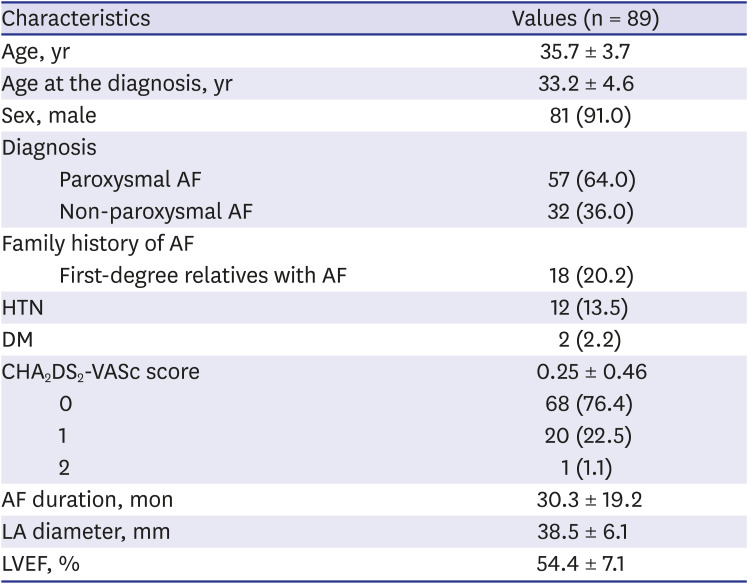
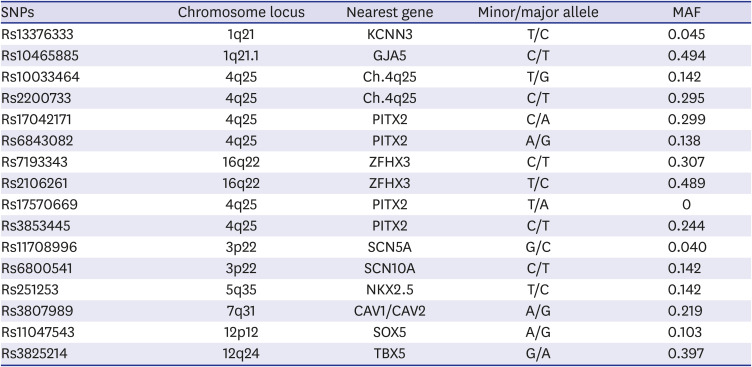


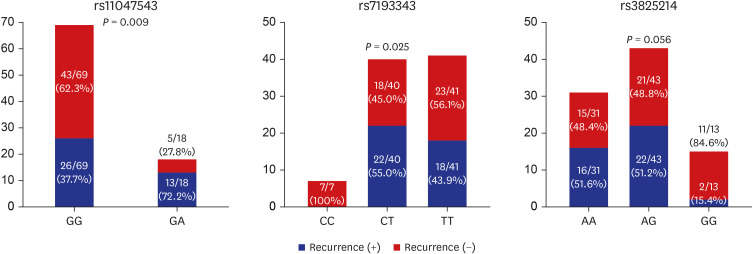






 PDF
PDF Citation
Citation Print
Print



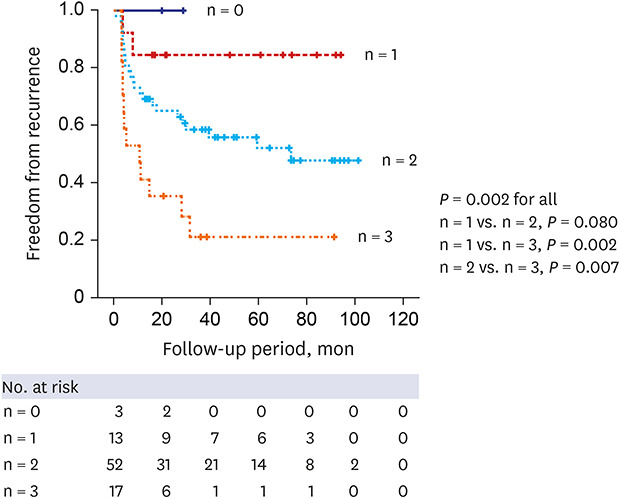
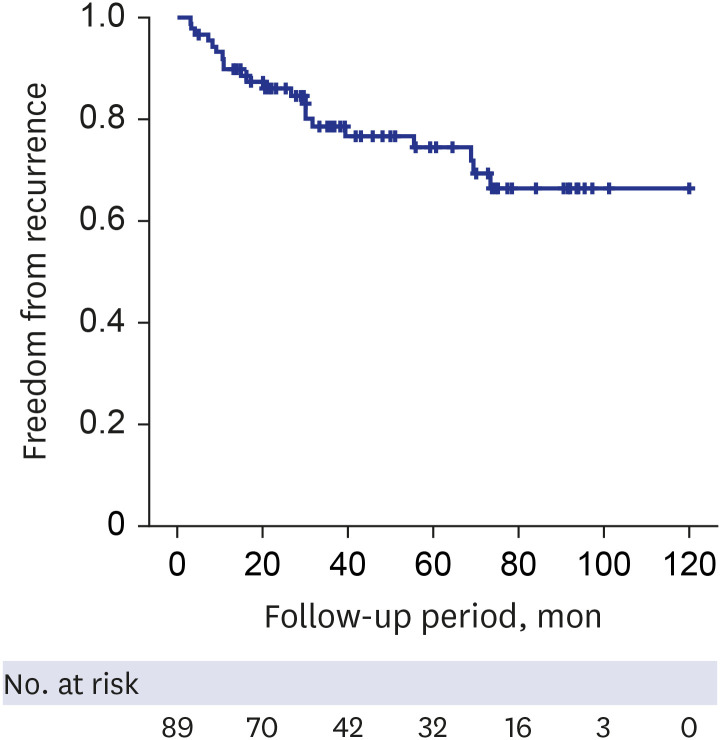
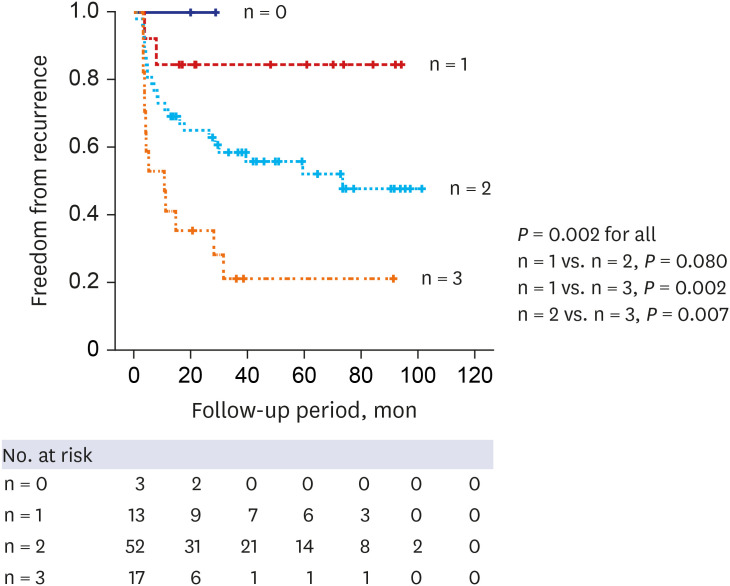
 XML Download
XML Download